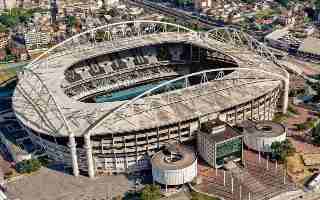Estádio Nilton Santos (Engenhão)
| Capacity | 44 661 |
|---|---|
| Country | Brazil |
| City | Rio de Janeiro |
| Clubs | Botafogo FR |
| Other names | Estádio Olímpico João Havelange (2003-2015) |
| Inauguration | 30/06/2007 |
| Construction | 2003-2007 |
| Renovations | 2013, 2016, 2017 |
| Record attendance | 43 810 (Fluminense - Botafogo, 30/06/2007) |
| Cost | R$ 380 million |
| Design | Carlos Porto |
| Address | R. José dos Reis, 425 - Engenho de Dentro, Rio de Janeiro - RJ, 20770-001 |
Advertisement
Estádio Nilton Santos – stadium description
When it was still only on renderings back in 2003, mayor’s office estimated costs to be around $30m. After finishing with delays in 2007, the budget turned out to be 533% higher with total cost at $192m. For this price Rio received its largest athletics venue with possibility to expand further at end zones. It was finished just ahead of 2007 Panamerican Games, for which it was designed.
Slow construction earned it quite some criticism. To add to that, right after finishing a massive wall (15 by 6 meters) fell down, thankfully not leaving anyone injured. And even more, aesthetics are arguable with sightlines far from optimum for football fans. Those are most frequent users of the stadium with local team Botafogo having signed lease (until 2027) and other clubs (Fluminense, Flamengo and occasionally Brazilian national side) also dropping by while other venues are being revamped.
Apart from football and the 2007 Panamerican Games, it was also the main athletics venue for 2016 Olympics and Paralympics. Concerts are also being organized here when not in football use with other sports being rather rare.
The ground was named after João Havelange, long time sports official (among other roles – FIFA president). In 2012 controversy has sparked after documents proving Havelange’s corruption were released. From 2015 onwards the official name has been changed to that of Nilton Santos, legend of Botafogo.
Despite the stadium's relatively young age, it was subject to huge controversy in structural terms. In 2013 it had to be closed to the public for fear of roof's instability during high winds. Further works included renovations for the 2016 Olympics and then return to regular football use in 2017.
Advertisement
Pictures

2021 © instagram: @cairo.pilot 
2021 © instagram: @cairo.pilot 
2021 © instagram: @cairo.pilot 
2021 © instagram: @cairo.pilot 
2021 © instagram: @cairo.pilot 
2021 © instagram: @cairo.pilot 
21.01.2017 © Diario MxM, Botafogo FR 
21.01.2017 © Diario MxM, Botafogo FR 
21.01.2017 © Diario MxM, Botafogo FR 
21.01.2017 © Diario MxM, Botafogo FR 
21.01.2017 © Diario MxM, Botafogo FR 
21.01.2017 © Diario MxM, Botafogo FR 
21.01.2017 © Diario MxM, Botafogo FR 
21.01.2017 © Diario MxM, Botafogo FR
Related news
2025
2021
2020
2017
2016
-

Rio 2016: Meet the Olympic venues
As we’re just hours away from the opening ceremony, here are the stadiums hosting Olympic football and many more events!
-

Rio de Janeiro: The football crisis behind 2016 Olympics
Main stadium for this year’s Olympics has no water and electricity. These were cut off due to debt. But Botafogo, the club owing money, have much, much larger financial issues than just water bills.
2015
2014
-

Rio de Janeiro: Engenhao reopening soon
After 18 months of analysis and repairs the Olympic Stadium in Rio de Janeiro is about to reopen its doors. But there’s more work to be done ahead of the 2016 Olympics.
-

Rio de Janeiro: Clashes outside Engenhão as workers strike
While Brazilian World Cup stadiums are in the spotlight, now it's trouble again at the 2016 Olympics main arena. Scuffles broke out yesterday between security and protesting workers.
2013
-

Brazil: Botafogo left out in the rain without stadium?
Famous club won’t be able to play at Maracana and cannot return home as repair works begin at their Engenhao. The club are thought to play several fixtures as far as 1,000-2,000 km away from Rio de Janeiro – SambaFoot.com reports.
-

Rio de Janeiro: 2016 Olympics stadium closed for 18 months
Exactly 18 months – this is how long repair works are thought to take and how long before Rio Olympics they’re scheduled to end. Popular Engenhão is to be reopened in 2015, as its roof structure was found to be in danger of collapsing.
-

Rio de Janeiro: 2016 Olympic stadium roof poses threat to safety
Though built just 6 years ago, most modern stadium in Rio de Janeiro has structural issues that could lead to tragedy if not dealt with. Roof supports are cracked and the structure moves alarmingly. Rio mayor closed the stadium indefinitely.
2012
-

Brazil: No name change for Estádio Havelange?
Rio 2016 organising committee denied claims that patronage of João Havelange may have negative influence on the image of their event. Before closing ceremony in London they claimed no name change is needed.
-

Brazil: Shame on Havelange, fans demand stadium name change
Until last week, the name Havelange referred to a football legend. But as it turned out, longstanding FIFA president João Havelange was part of a bribery scandal. Now supporters of Botafogo demand renaming of their stadium as it bears his name, Reuters informs.

 StadiumDB
StadiumDB



